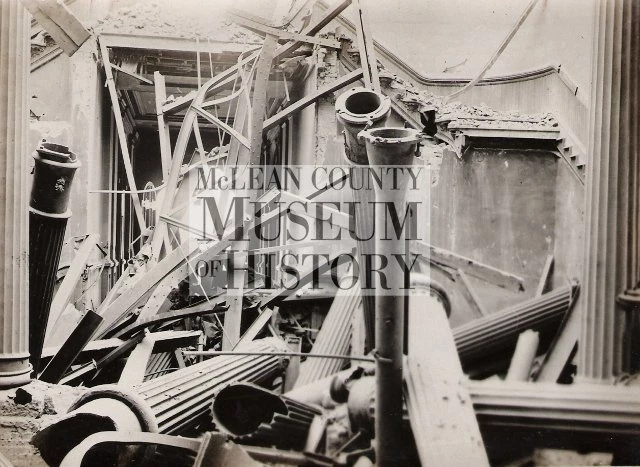Just after midnight on June 19, 1900, a great fire began sweeping through much of the city's downtown. By 8 a.m. the next morning, stunned residents struggled with the enormity of the devastation - 45 buildings and 5 1/2 blocks reduced to little more than smoking rubble.
It all began at 12:20 a.m., when Bloomington patrolman John Brennan spotted flames in a second-story window of Model Laundry in the 100 block of East Monroe Street between Main and East streets.
Flames quickly spread to Benoni S. Green's harness and saddlery business immediately to the east. From the beginning, antiquated equipment combined with low water pressure hampered Bloomington firefighters.
Steady winds pushed the fire in a southwesterly direction, and within an hour flames had engulfed most of the block running from Main to East and Monroe to Jefferson streets.
The fire spread to the east and north sides of the Courthouse Square. Even the largest, most substantial brick structures, such as the five-story Griesheim Building, proved no match for the flames and blast-furnace-like heat. This high rise, at the southeast corner of Main and Jefferson, was home to Wolf Griesheim's street-level men's clothing store and more than 30 doctor, dentist and law offices.
At 2:30 a.m., Bloomington Mayor Lewis B. Thomas requested assistance from the Peoria and Springfield fire departments. Both arrived around 5 a.m., coming by express train with their equipment lashed to railcars.
Burning embers and sparks filled the air. Sparrow nests on the courthouse roof caught fire, and the flames spread to the wooden rafters. Thus, the supposedly fireproof building burned from within. By morning, according to one account, the courthouse resembled "a skull, sightless and cavernous."
On the north side of the square, the fire jumped across Center Street, bringing down the Windsor Hotel (today the site of the Illinois House) and an old Baptist church, then serving as a livery stable (today Pantagraph Printing & Stationery Co.).
Thankfully, the flames spread no farther, due in part to the efforts of local residents manning rooftop "bucket brigades." The last blaze was extinguished a little before 8 a.m. Later on, paper and letters were found in farm fields three to four miles southwest of downtown, carried by the maelstrom's updraft and the strong winds.
Estimates placed the losses at more than $2 million (or more than $50 million today, adjusted for inflation)
Remnants from the courthouse:
Surviving capitals (the architectural term for the tops of columns): Dimmitt's Grove neighborhood east of downtown: the southeast corner of Grove and McLean streets and the southwest corner of Washington and Evans. A third capital can be found at the Emerson Street entrance to White Place.
The Summit Street Bridge: Four pilasters, (the architectural term for a flat column attached to a wall), are part of the Summit Street Bridge on Miller Park's eastern edge. The bridge's infilling stonework, contrary to stubborn local tradition, did not come from the courthouse.
The Dome: The most distinctive remnant at Miller Park is the dome's framework. Two months after the fire, the iron "ribs" of the dome were brought to Miller Park and reassembled. It was then covered with a wire screen to serve as a "cage" for zoo animals. At one point, city workers moved the dome to a small island on the park's manmade lake, where it became a habitat for monkeys. Though the island is gone, the dome remains a feature of Miller Park, and now stands east of the pavilion, minus the chattering monkeys, of course.
The Bell: During the fire the 2,900-pound bronze bell crashed through the building's rotunda, embedding itself into the basement floor. Happily, the county salvaged the bell, and it was eventually reinstalled in the successor courthouse.



























